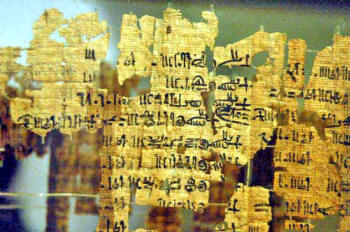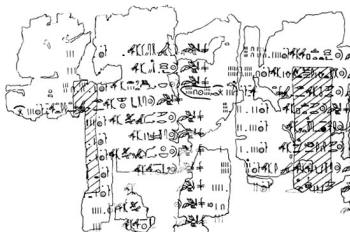|

from
AncientEgypt Website
The Turin Kinglist, also known as
the Turin Royal Canon, is a unique papyrus, written in
hieratic, currently in the Egyptian Museum at Turin, to which it
owes its modern name.
It is broken into over 160 often very small fragments, many of which
have been lost.
When it was discovered in the Theban necropolis by
the Italian traveller Bernardino Drovetti in 1822, it seems
to have been largely intact, but by the time it became part of the
collection of the Egyptian Museum in Turin, its condition had
severely deteriorated.
 
Turin Kinglist
The importance of this papyrus was first recognized by the French
Egyptologist Jean-François Champollion, who, later followed
by Gustavus Seyffarth took up its reconstruction and
restoration.
Although they succeeded in placing most of the
fragments in the correct order, the diligent intervention of these
two men came too late and many lacunae to thus important papyrus
still remain.
Written during the long reign of Ramesses II, the papyrus, now
estimated at 1.7m long and 0.41m high, comprises on the recto an
unknown number of pages that hold a list of names of persons and
institutions, along with what appears to be the tax-assessment of
each.
It is, however, the verso of the papyrus that has attracted the most
attention, as it contains a list of gods, demi-gods,
spirits,
mythical and human kings who ruled Egypt from the beginning of time
presumably until the composition of this valuable document.
The beginning and ending of the list are now lost, which means that
we are missing both the introduction of the list - if ever there was
such an introduction - and the enumeration of the kings following the
17th Dynasty.
We therefore do not know for certain when after the
composition of the tax-list on the recto an unknown scribe used the
verso to write down this list of kings. This may have occurred
during the reign of Ramesses II, but a date as late as the 20th
Dynasty can not be excluded.
The fact that the list was scribbled on
the back of an older papyrus has been seen by some as an indication
that it was of no great importance to the writer. Perhaps it was a
text that needed to be copied in a scribes' school by way of
exercise?
We are also left in the dark as to what source or sources our
laborious scribe used to write down the list.
-
Did he simply copy an
already existing papyrus?
-
And if so, for what reason?
-
And what has
happened to the original?
-
How was that compiled?
-
Or did the scribe,
probably having access to the archives of the temples, compile the
list himself, using ancient tax-notes, decrees and documents?
The
latter possibility seems the less likely and would infer that the
Turin Kinglist is indeed a unique document.
There are several other lists that enumerate the predecessors of a
king, such as the lists in the temples of Seti I and Ramesses II at
Abydos -to name but two-, so what makes the Turin Kinglist so
exceptional?
The other lists, although very valuable for the study
of Ancient Egyptian chronology as well, are nothing more than an
enumeration of some of the "ancestors" of the current king.
Often the current king, or one of his
contemporaries, is seen in adoration before the cartouches or
representations of the king’s "ancestors".
The current king is in
fact represented as the good heir who pays respect to his long line
of "ancestors". The word "ancestor" can not be taken literally, as
the current king was in no way a descendant of most of his
predecessors.
Such lists had a more cultic and political reason for
being, for indeed they confirmed that the current king was the
rightful heir of the kings that had ruled Egypt for many centuries.
These cultic lists are more a subjective
choice of predecessors than an actual enumeration of all kings:
they
will in most cases include kings such as Menes and Mentuhotep II,
for they have played a pivotal role in the history of Ancient Egypt.
Other, less important kings, usurpers or kings that were considered
to be illegitimate, such as the kings connected to the Amarna-revolution,
were omitted from the lists.
The Turin Kinglist, on the other hand, does a lot more than
simply list some kings: it groups them together and it mentions the
duration of their reigns. What’s more, it even takes note of some
kings that are omitted from the cultic lists, such as the otherwise
quite unpopular Hyksos!
Despite the fact that it begins with an
enumeration of gods, demi-gods, spirits and mythical that were
supposed to have ruled Egypt before the reign of Menes, it was not a
cultic list and it does not serve the purpose of showing the current
king as the good heir to his "ancestors".
The king list of the Turin Kinglist was originally divided
over an unknown number of columns or sheets, of which only 11
remain. Columns I to V comprised 25 or 26 lines of text, column VI
at least 27 and columns IX and X at least 30.
The increasing number
of lines as the Canon reaches its end seems to indicate that the
scribe realized that he would not have sufficient space on his
papyrus to write down all the royal names known to him in 25- or
26-line columns.
Most lines give the name of a particular king, written in a
cartouche, followed by the number of years he ruled, and in some
cases even by the number of months and days. The number of years
credited to some kings of the 1st and 2nd Dynasty is so high, that,
in those particular cases, they are most likely not correct.
It has
sometimes been postulated that this high number of years does not
reflect the length of a reign but the age at which the king died.
Although this possibility can not
entirely be overruled, it is strange that the writer should choose
to note the age of a king in one case and the length of his reign in
another. I would rather suspect that the scribe mistook the
year-labels of early kings as representations of different years,
whereas it is likely that several labels actually referred to the
same year..
For the kings of the first three dynasties, a name is written in a
cartouche as well, despite the fact that cartouche-names were not
used prior to the rule of the last king of the 3rd Dynasty, Huni.
The cartouche-name used for these kings is often similar to the
names used for the same kings in the cultic king-lists, but they are
quite different from the Horus-name by which they were known
officially during their reign.
The relationship between the Horus-names
of these early kings and the names used in the Turin Kinglist is not
certain: for the later 1st Dynasty kings, the name in the kinglists
seems to be based on their Nebti-name, but how the earlier kings of
the 1st Dynasty and all kings of the 2nd and 3rd Dynasties got their
names is not known.
The kings are grouped together logically based on the city where
they took up residence. These groups do not (entirely) correspond to
the dynasties into which the kings were placed
by Manetho.
This
indicates that the notion of dynasties was not present or fully
developed before the 19th or 20th Dynasty.
Most groups comprise a line of summation that totals the number of
years that this particular group has ruled. These summations are
sometimes written on 1 line, sometimes divided over 2 lines and
sometimes written in 1 line that is so long that it encroaches the
next column. In some cases a group is introduced by a heading.
The
fact that there are far less headings than summations may rather be
the result of the fragmentary state of the Canon than an
inconsistency on the part of the scribe who wrote or copied the
list.
Despite its incomplete and fragmentary nature, and despite the fact
that the placing of the fragments has been contested from time to
time, the Turin Kinglist is one of our most important sources of
knowledge about the chronology of Egypt between the 1st and 17th
Dynasty.
The following pages contain a hieroglyphic transcription of that
part of the Turin Kinglist that lists actual kings. The
transcription has been based on the publication of the Turin Kinglist by
Alan H. Gardiner. Although a rather old publication (the
first edition is dated to the late 50's), the placement of the
different fragments as proposed by Gardiner is still largely
accepted by most Egyptologists.
Since his publication, other
fragments seem to have been placed as well.
This will not yet be
reflected in my current transcription of the Canon.
When making this hieroglyphic transcription, I have tried to respect
the disposition of the signs as much as possible, except that I have
oriented the signs from left to right for practical reasons, instead
of from right to left as they were written in the original hieratic
text.
The translations are written in italics and are my own. Words in the
translation that are written in red were written in red ink in the
original text as well.
Translations between [ ] are restorations of
smaller lacunae. Where a restoration of a lacuna was not possible or
uncertain, the signs /// will appear.
If the need arises to make some additional remarks about a
particular line of text, this will be done using a smaller font.
A total of 16 "groups" can be distinguished (clicking on the links
below will take you to a hieroglyphic transcription and a
translation of that particular group):
Contents
-
I,x - I,21: Ptah and the
Great Ennead
-
I,22 - II,3 : Horus and the
Lesser Ennead (?)
-
II,4 - II,8 : the spirits
-
II,9 : a mythical group of
kings
-
II,10 : another group of
mythical kings (?)
-
II,11 - III,26/27: 1st to
5th Dynasty
-
IV,1 - IV,14/15: 6th to 8th
(?) Dynasty
-
IV,15/17: 1st to 6th (or
8th ?) Dynasty
-
IV,18 - V,10: 9th and 10th
Dynasty
-
V,11 - V,18: 11th Dynasty
-
V,19 - VI,3: 12th Dynasty
-
VI,4 - X,12/13: 13th and
14th Dynasty
-
X,14 - X,21: 15th Dynasty (Hyksos)
-
X,22, X,30 (?): a group of
non-identified kings
-
XI,1 (?) - XI,15: a group
of probably Theban kings contemporary with the Hyksos
(17th Dynasty ?)
-
unplaced fragments
|



